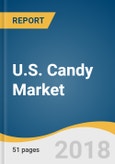The U.S. candy market is expected to reach a value of USD 19.6 billion by 2025. Growing consumer expenditure and disposable income and increasing trend towards urbanization is driving the growth of the candy market in the U.S. Candies and chocolates are generating huge amount of sales in the U.S. targeting the sweet tooth among the people. Huge revenue generation of candies is primarily due to their consumption during holidays like Halloween and Easter accounting for around USD 3.5 billion sales.
Currently, around 82% of the population in North America are living in the urban areas with high concentration in mid and large-sized cities. Such huge trend towards urbanization has led to growing awareness for new products and their easy availability. This is due to the fact that giant players have a significant hold of the candy market in the urban areas.
Children with inclination towards a sweet tooth is a major factor driving the demand of the products. Hence, this group of population is a huge contributor towards revenue generation of the market. Moreover, key players are creating appealing advertisements targeting the children and young population, thus, attracting them towards impulse purchase. Teenagers are also a significant target population for candies, especially chocolate candies due to high preference for the chocolate flavor.
Increase in product innovation and new product development has led to high growth of the market. Sugar-free candies manufactured by the key players is further expected to boost the market demand for the diabetic population. Companies are also engaged in new product launch, which is further boosting the demand for candies. For instance, in March 2017, Hershey’s Reese’s brand launched Reese’s Crunchy Cookie Cup. In May 2016, DeMet’s Candy Company launched a new product, TURTLES Double Chocolate.
Further Key Findings From the Study Suggest:
Currently, around 82% of the population in North America are living in the urban areas with high concentration in mid and large-sized cities. Such huge trend towards urbanization has led to growing awareness for new products and their easy availability. This is due to the fact that giant players have a significant hold of the candy market in the urban areas.
Children with inclination towards a sweet tooth is a major factor driving the demand of the products. Hence, this group of population is a huge contributor towards revenue generation of the market. Moreover, key players are creating appealing advertisements targeting the children and young population, thus, attracting them towards impulse purchase. Teenagers are also a significant target population for candies, especially chocolate candies due to high preference for the chocolate flavor.
Increase in product innovation and new product development has led to high growth of the market. Sugar-free candies manufactured by the key players is further expected to boost the market demand for the diabetic population. Companies are also engaged in new product launch, which is further boosting the demand for candies. For instance, in March 2017, Hershey’s Reese’s brand launched Reese’s Crunchy Cookie Cup. In May 2016, DeMet’s Candy Company launched a new product, TURTLES Double Chocolate.
Further Key Findings From the Study Suggest:
- Chocolate candies dominated the market in 2016 and is also expected to show high CAGR over the forecast period due to the numerous health benefits associated with these products
- Non-chocolate candies held significant market share in 2016 owing to a wide variety of flavors as well as sugar-free candies available in the market
- Gummies contributed significantly in the U.S. candy market due to its huge customer preference and availability of different shaped gummies
- Based on the end-use segment, super/hyper markets dominated the market in 2016 due to its huge storage capacity and organized aisle format leading to a convenient shopping
- Online stores segment is projected to witness lucrative CAGR over the forecast period due to the lucrative offers and discounts available
- Few key companies are Ferrara Candy Co.; The Hershey Company; Mondeléz International Inc.; Nestlé SA; and DeMet’s Candy Co.
Table of Contents
Chapter 1 Executive Summary
Chapter 2 Research Methodology
Chapter 3 U.S. Candy Market Variables, Trends & Scope
Chapter 4 U.S. Candy Market: Product Estimates & Trend Analysis
Chapter 5 U.S. Candy Market: End Use Estimates & Trend Analysis
Chapter 6 Competitive Landscape
List of Tables
List of Figures
Companies Mentioned
- The Hershey Company
- Ferrara Candy Co.
- Mars Incorporated
- Mondeléz International Inc.
- DeMet’s Candy Co.
- Nestlé SA.
Methodology

LOADING...








